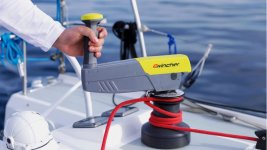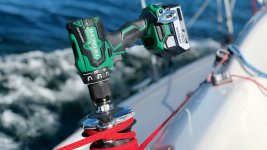There are electrical winch handles--and some adaptors for any portable drill battery. 12V DC or even mains power if you are running an inverter or generator to recharge the battery in either type of electrical winch handle.
A specific battery powered winch handle:

If you have the drill and batteries, An adaptor chucked in a drill for a few bucks sure beats the $900 for an electric handle. This is a "self tailing winch"--for those who are not familiar, many of the early winches required a person to pull on the line as it came off the winch, to provide the friction to hold the line tightly on the winch--thus you may require an extra crewman to "tail" the winch. Good crew members can be hard to find, and they have to be fed and taken care of--especially on races which last over a week--to Hawaii, or La Paz, Mexico etc. Where you may have to fly the crew home on your dime. Then a short handed delivery crew has to take the boat back to its home port. ($$$) 9 crew members, plus 4 crew members flown from the US mainland to the port where the race finished, and paid $300 to $500 a day, plus food, and fuel. Occasionally some of the racing crew may have the extra two or more weeks to help bring the boat back.--that saves the air fare. Also one had to be very specific with a contract to clarify that the racing crew member wa not paid for time while racing. Also the insurance rider for a long race--plus it used to be a Single Side band radio was also reqiued--now it is satellite communicator and tracker.
Below is an example of an off the shelf battery operated drill motor with an adaptor for the ~ 1 inch square winch socket. Many are 8 point sockets rather than 4 sided winch handle.

I would not use an electric handle while racing, but manual winch handles at $60 to $100 a pop gets expensive if one was dropped overboard during each race. They even made floating winch handles--as if a racing skipper would drop out of the race to try and find a winch handle--basically about 12" long and 1.5 inches thick in choppy watters.
For those who have not been ocean racers on sailboats, with a 10 man crew, half would be off "watch" and resting or sleeping. The other 5 would be on deck. I liked 3 hour watches, but some skippers like 2 hours (for me the two hours off would not allow much sleep, especially if they needed food, and to change out of wet foul weather gear. They would trim sail and steer the boat. I always wanted at least 2 good helmsmen on the watch. It usually takes a few minutes to go to sleep (especially in a noisy racing boat, with winches adjusting the trim of sails, and crew members running or walking on deck, plus the noise of the water hitting the hull. 3 hours off would generally give you 2+ hours of sleep. The off watch is expected on deck with appropriate clothing and safety gear in place (tether to keep the person from being washed overboard)--also some form of locator beacon and strobe light if they went overboard.
During the 1951 Transpacific Yacht Race to Hawaii, a sailor named Ted Sierks fell overboard from the vessel L’Apache, about 800NM from Hawaii. Sierks was an ex-marine and a photographer, and he had gone aft to repair a “boom tackle” on the 72’ vessel. While leaning against the stern railing, it gave way, and he fell into the Pacific without the benefit of a life jacket. The crew was able to throw a life ring, equipped with a knife and a flashlight, in his direction. They dropped the spinnaker and began a day-long search but were unable to find their crewman. Dejectedly, they sailed on to Honolulu.
Hearing of the incident by radio, the Navy sent a veritable flotilla to help in the search, including a “an escort carrier, four destroyers, three destroyer escorts”. In addition, a B-17 from Hickam Air Field joined in the search. During his time in the water, Sierks was forced to defend himself from sharks on two occasions. After over 30 hours in the water, the Navy destroyer, Douglas A Munro, spotted Mr. Sierks and rescued him
In some racing conditions, even a very good helmsman could have full sharp focus for only an hour. It is just not steering a compass course, but "working" the puffs in always slightly variable wind direction. If a major sail change was necessary, such as running one spinaker up, before taking the other spinnaker down then it would be all 10 persons on deck. That was an example of all hands necessary.
A spinnaker is usually a light weight nylon material typically 3/4 ounce to as much as 1.5 ounces per square yard of spinnaer cloth. The range of cloth weight available is from 0.5 ounces to 4 ounces. The cloth is available from 0.5 oz to as much as 4 ounces per square yard, There are several spinnaker shapes as well as size. One large racing boat which I was watch captain and primary helmsperson was owned by a sailmaker, so we usually had 4 or more spinnakers and as many as 6 foreward triangle sails. (He had a large locker under the fore deck and accessed thru a 36" wide hatch which a man would go into this locker to pack and re-bag each sail as it was used and pass up the sail to replace the one taken down (again hoisting one sail inside of the other which usually required 3 crew members.)
The spinnaker is that light cloth sail which balloons out forward of the mast and forestay. Most have a "pole" which helps to hold it out. There also "asymmetrical "spinnakers not requiring a pole. Mostly seen of cruising boats.
Also fore sails such as Jibs and Genoa sails that have to be changed depending on wind strength and direction.


